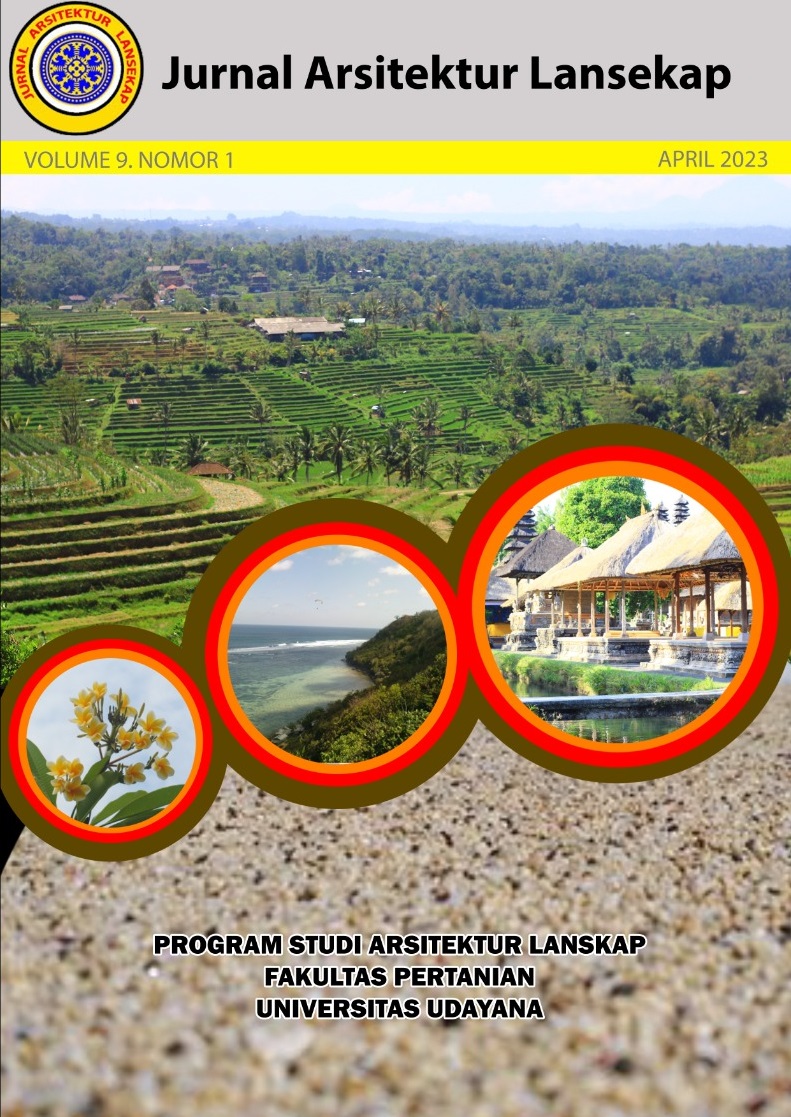Redesign Peningkatan Fungsi Mixed Use Area Jalan Jendral Soedirman Kota Salatiga melalui Re-desain Jalur Pedestrian
Abstract
Increasing the Mixed Use Function of the Jendral Soedirman street Area, Salatiga City through Redesigning Pedestrian Pathways. Jendral Sudirman street is Salatiga's busiest business district and economic center. The Jendral Sudirman street business district is used for a variety of purposes, including shopping areas, traditional markets, modern markets, offices, places of worship, hotels, and education. Based on the amount of human movement in the Jendral Sudirman street business area, both by vehicles and pedestrians. However, the area lacks the adequate pedestrian infrastructure to support pedestrian activity. As a result, a review of the pedestrian path's planning and redesign was conducted, taking into account the site's location, materials, and the requirement for facilities and infrastructure. The study used qualitative descriptive method to determine the landscape, planning, and develop a design for the pedestrian path in the Jendral Sudirman street business area using the data obtained through analysis and synthesis. The newly designed tools are powered by Autocad for making siteplan and Google SketchUp for making visual 3D design. The pedestrian redesign of the Jendral Sudirman Road business district is based on the concept of keeping people safe and comfortable. The result indicate that Jendral Sudirman street business area is divided into three zones based on its characteristics, with each zone utilizing andesite stone guiding blocks and pedestrian lamps to increase safety and comfortable for pedestrians and people with disabilities in the night. In terms of comfort, there will be provided shade trees, trash cans, and benches to encourage pedestrian activity on Jenderal Sudirman street.
Downloads
References
[KEMENPUPR] Kementrian Pekerjaan Umum dan Perumahan Rakyat. 2018. SE Menteri PUPR tentang Pedoman Perencanaan Teknis Fasilitas Pejalan Kaki. No. 02/SE/M/2018.
Anggraiani, N. (2009). Pedestrian Ways dalam Perancangan Kota. Yayasan Humaniora.
Ade Syoufa. 2017. Tinjauan Tingkat Kenyamanan Dan Keamanan Pejalan Kaki Pada Desain Trotoar Jalan Margonda Raya Depok Dengan Jalan Padjajaran Bogor. Jurnal Desain Konstruksi Volume 16(2): 142-150.
Agus R. 2017. Evaluasi Lanskap Jalan Jenderal Ahmad Yani Pontianak. E-JURNAL ARSITEKTUR LANSEKAP 3(1): 49-57.
Anggraiani, N. (2009). Pedestrian Ways dalam Perancangan Kota. Yayasan Humaniora
Ashadi, Houtrina, R., & Setiawan, N. (2012). Analisa pengaruh elemen-elemen pelengkap jalur pedestrian terhadap kenyamanan pejalan kaki studi kasus: pedestrian orchard road singapura. Nalars, 11(1), 77–90.
Ersina, S., Rahayu, I., & Yuliana. (2017). Jalur Pedestrian Sebagai Salah Satu Fasilitas Perkotaan di Jalan Prof. Abdurahman Basalamah, Makassar. National Academic Journal of Architecture, 4(1), 57–65.
Hendrawan C, Yohanes B D. 2017. Konsep Active Living Dalam Perancangan Jalur Pedestrian, Jurnal Teknik Arsitektur ARTEKS 2(2): 15-31.
Mauliani, L., Purwantiasning, A. W., & Aqli, W. (2015). Menciptakan Lingkungan Yang Lebih Baik Dengan Penyediaan Jalur Pedestrian Bagi Pejalan Kaki. Jurnal Arsitektur NALARS, 14, 47–58. https://jurnal.umj.ac.id/index.php/nalars/article/view/177
Nasrudin, Na’asah; Sarimin, Muna; Ibrahim, Norhayati. 2018. Assessing a Walkable Environment in Jalan Tuanku Abdul Rahman, Kuala Lumpur, Malaysia. Planning Malaysia: Journal of the Malaysian Institute of Planners. 16(3). pp. 26 – 27
Peraturan Menteri Pekerjaan Umum Nomor : 05/PRT/M/2012. 2012. Tentang Pedoman Penanaman Pohon Pada Sistem Jaringan Jalan. Jakarta: Kementrian Pekerjaan Umum.
Prasetya R, Maria I M R W. 2020. Kenyamanan Sirkulasi Jalur Pedestrian Di Jalan Ahmad Yani Sukabumi Berdasar Persepsi Pengunjung. MINTAKAT Jurnal Arsitektur, 21(1): 21-33.
Rahmiati M. 2009. Studi aspek kenyamanan ruang pedestrian dalam rangka peningkatan efektivitas penggunaannya pada kawasan jalan m.h. thamrinjend sudirman jakarta. [tesis]. Bogor (ID): Program Pascasarjana, Institut Pertanian Bogor.
Rubenstein, H.M., 1992. Pedestrian Malls, Streetcapes, and Urban Spaces, New York: John Wiiley & Sons Inc.
Sakinah, R., Kusuma, H. E., Tampubolon, A. C., & Prakarso, B. (2018). Kriteria Jalur Pedestrian di Indonesia. Jurnal Lingkungan Binaan Indonesia, 7(2), 81–85. https://doi.org/10.32315/jlbi.7.2.81
Windi H F H. 2015. Kenyamanan Pejalan Kaki Terhadap Pemanfaatan Jalur Pedestrian Di Jalan Jamin Ginting Medan. Jurnal Arsitekno 5(5): 1-10

This work is licensed under a Creative Commons Attribution-ShareAlike 4.0 International License.
An author who publishes in the Jurnal Arsitektur Lansekap (JAL) agrees to the following terms:
- Author retains the copyright and grants the journal the right of first publication of the work simultaneously licensed under the Creative Commons Attribution-ShareAlike 4.0 License that allows others to share the work with an acknowledgement of the work's authorship and initial publication in this journal
- Author is able to enter into separate, additional contractual arrangements for the non-exclusive distribution of the journal's published version of the work (e.g., post it to an institutional repository or publish it in a book) with the acknowledgement of its initial publication in this journal.
- Author is permitted and encouraged to post his/her work online (e.g., in institutional repositories or on their website) prior to and during the submission process, as it can lead to productive exchanges, as well as earlier and greater citation of the published work (See The Effect of Open Access).
Read more about the Creative Commons Attribution-ShareAlike 4.0 Licence here: https://creativecommons.org/licenses/by-sa/4.0/.







